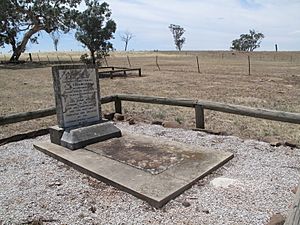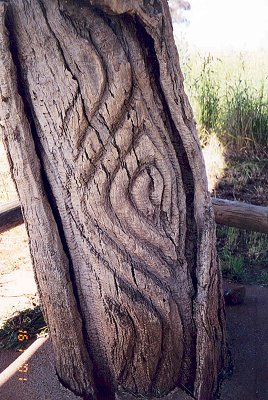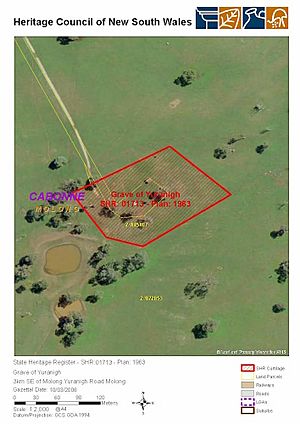Grave of Yuranigh facts for kids
Quick facts for kids Grave of Yuranigh |
|
|---|---|

Yuranigh's gravesite, 2013
|
|
| Location | 3km SE of Molong Yuranigh Road, Molong, Cabonne Shire, New South Wales, Australia |
| Built | 1852–1852 |
| Official name: Grave of Yuranigh; Yuranigh's grave | |
| Type | state heritage (archaeological-terrestrial) |
| Designated | 10 March 2006 |
| Reference no. | 1713 |
| Type | Burial |
| Category | Aboriginal |
| Lua error in Module:Location_map at line 420: attempt to index field 'wikibase' (a nil value). | |
The Grave of Yuranigh is a special historical site. It is located about 3 kilometers south-east of Molong in New South Wales, Australia. This grave marks the resting place of Yuranigh, an important Aboriginal guide. He helped explorer Thomas Mitchell on his journeys. The grave was built in 1852. It is also known as Yuranigh's grave. This site was added to the New South Wales State Heritage Register on March 10, 2006.
Contents
Yuranigh's Story: An Explorer's Guide
Yuranigh was an Aboriginal man from the Boree area. He joined the famous explorer Thomas Mitchell on a big trip. This journey was Mitchell's fourth and last exploration into north-west Australia. The group started their trip on December 15, 1845. They had 29 European men and three Aboriginal people, including Yuranigh.
As the journey went on, Yuranigh became very helpful. Mitchell was very thankful for his help. Yuranigh was good at talking to other Aboriginal groups. This helped the explorers pass safely through different territories. He also knew a lot about the bush. He gave Mitchell important advice about the land. Mitchell wrote in his journal that Yuranigh was his "guide, companion, counsellor and friend."
After the exploration trip, Yuranigh went with Mitchell to his home in Sydney. But Yuranigh did not like city life. He soon left to work as a stockman on a cattle station in the north.
Yuranigh's Burial Site
On July 13, 1850, Mitchell learned that Yuranigh had died. He passed away at the old Gamboola Station, near Molong. Following their traditions, Aboriginal people buried Yuranigh there. They marked his grave with four special carved trees. Early settlers said it was common for Aboriginal people to carve trees around the grave of an important person. All the carvings faced Yuranigh's grave.
Today, only one of these four trees, which is now dead, clearly shows its carvings. The carvings on the other trees are mostly covered by new growth. The clear carving is a spiral shape. It is surrounded by a pattern that looks like a triple "S" shape.
Both Aboriginal people and Europeans have shown respect for Yuranigh's grave. The four carved trees around the grave show that Aboriginal people believed he was very important. A fence and a memorial stone were also put up by Europeans. This shows respect in the European tradition.
What the Grave Looks Like
The grave has a headstone. This stone honors Yuranigh's bravery, honesty, and loyalty. At each corner of the burial area are four carved trees. Like the grave itself, these trees are fenced to protect them. One tree is dead, and its carving is very clear. The other trees are alive, and their carvings are harder to see because of new growth.
Yuranigh was one of Thomas Mitchell's guides. He died sometime between 1847 and 1852. In 1852, the New South Wales Government paid for the memorial headstone. This headstone is still there today. The grave is considered the best-preserved Aboriginal burial site in the region.
The grave has a marble headstone with words carved into it. The grave is set in a concrete slab. A sandstone slab is also part of the concrete, with another inscription. The grave faces south-west. It is surrounded by a white wooden fence with chicken wire. The fence measures about 3.2 meters by 3.6 meters.
Why Yuranigh's Grave is Important
Yuranigh's grave is a great example of "culture contact." This means it shows how two different cultures came together. The carved trees around the grave show how Aboriginal people honored him. The carved headstone shows the respect given to Yuranigh by Major Mitchell. Yuranigh was Mitchell's guide on his famous journey to the north-west.
The carved trees are also special because they are the longest-lasting group of carved trees around a grave that we know of.
The Grave of Yuranigh was listed on the New South Wales State Heritage Register on March 10, 2006. It met several important requirements:
- A Link to History: The grave is important because it shows how Australia's inland was explored. It also shows positive connections between Aboriginal and non-Aboriginal people during colonial times.
- Connected to Important People: It is linked to Major Thomas Mitchell and his guide Yuranigh. It also connects to the Wiradjuri people of the Central West of NSW.
- Unique and Beautiful: The way the carved trees are arranged around the grave makes it stand out. It is unique among known graves from the contact era (when Europeans and Aboriginal people first met).
- Cultural Significance: The grave is important to the Wiradjuri communities in the Molong area. It helps them feel connected to their history and culture.
- Learning from the Past: This site can teach us a lot about how Aboriginal people were buried and honored. It shows how both Aboriginal and non-Aboriginal communities respected Yuranigh for almost 150 years. It also gives rare clues about how both Wiradjuri and English cultures viewed death and remembrance.
- Rare and Special: Yuranigh's grave is rare. It is one of the only known examples of a grave with both Aboriginal and European burial markers. It also shows the old custom of carving living trees near graves. This custom is no longer practiced.
- A Great Example: It is a great example of a grave that shows respect from two cultures for an important person. It also shows the customs and way of life of both the Wiradjuri people and the early European settlers.



